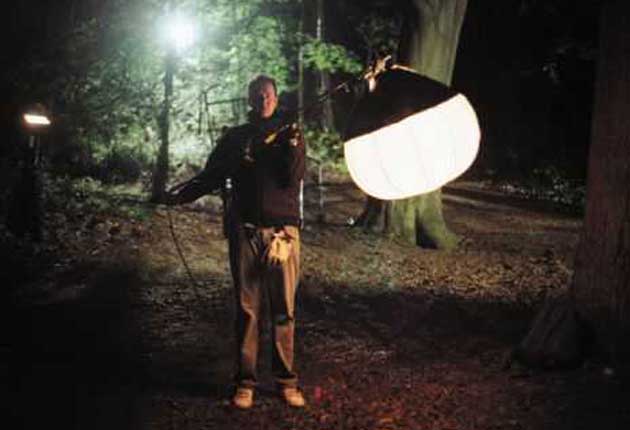Rosalind Nashabishi/ Richard Wright, ICA/ Gagosian Gallery, London
Lights, camera, action... almost

Rosalind Nashabishi is a film-maker and photographer who specialises in the depiction of voyeurism and role-play. Her films are self-conscious meditations upon the nature of film-making; broodings upon the processes that the material undergoes as it is being wilfully transformed into a spectacle fit for human consumption. Every element of the film is picked apart before our eyes – how image is manipulated by the overlaying of sound; how a camera angle can determine a mood. Many of them are shot on 16mm film, so that the whirring and the antique-sounding clatter of the projector at our back are all part and parcel of the experience. This is how the film experience comes to be what it is. That is what she is saying to us.
The film that seems best to demonstrate her preoccupations is Jack Straw's Castle, a 17-minute film which is being shown in one of the two upstairs galleries. This is a piece about the preparation of a film set, the stage-managing of an outdoors environment. We never see the finished set. The film gropes towards that moment, and it ends before the moment arrives.
It begins in a woodland, with a sweeping shot of sun-dappled treetops. Little by little, this benign patch of unspoiled paradise becomes colonised by burly men with cameras, scaffolding, walkie-talkies. It begins in daylight, but as the film progresses, the sun slowly sets, and an entirely different world is set in motion, newly fabricated by human beings with the aid of powerful spotlights. Light manipulated takes the place of natural sunlight. The place becomes estranged from itself, newly filmic. It begins to have slightly unnerving designs upon us and we know that, once some stirring music is added, the act of human manipulation will be complete. But we know that this estrangement, this newly imposed atmosphere of the film set, is a made thing. This degree of self-consciousness is the Brechtian element of the entire enterprise.
Richard Wright at the Gagosian is a show from one of this year's four Turner Prize contenders. But when I glance through the windows, I can't see anything at all. It reminds me of the time in the 1950s when Yves Klein had a show in Paris which consisted of himself in an empty room. He was the spectacle.
This is what Wright does, I remember then, just as I begin to look. He goes to a space, and he sizes it up. And then he draws in situ, on its surfaces, responding to the shape of the space, its atmosphere, the context of what he has been invited to appropriate. But only temporarily. These drawings don't go anywhere afterwards. Nobody tries to peel them off the walls. They remain here for the duration, they are documented with photographs, and then they get destroyed. Wright, like so many of his contemporaries, makes an art which comes and goes, and which perhaps is therefore making an allusion to the passing nature of life, and the necessary impermanence of art.
Rosalind Nashabishi to 1 November ( www.ica.org.uk )
Subscribe to Independent Premium to bookmark this article
Want to bookmark your favourite articles and stories to read or reference later? Start your Independent Premium subscription today.

Join our commenting forum
Join thought-provoking conversations, follow other Independent readers and see their replies